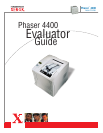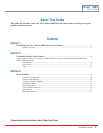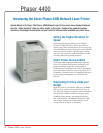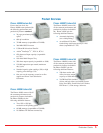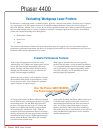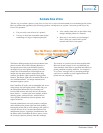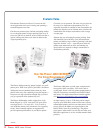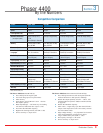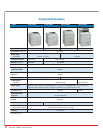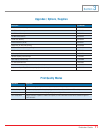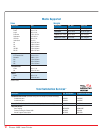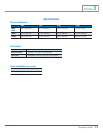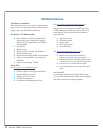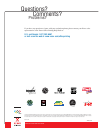
6
Phaser 4400 Laser Printer
Phaser 4400
Evaluate Performance Features
Today’s busy workgroups have no time to waste,
whatever their size. Consider raw engine speed, but also
look at RIP speed (largely determined by processor
speed), first-page-out time, and the ability to process
multiple jobs concurrently to give you a feel for the
printer’s total throughput capability.
Speed at the cost of quality is not acceptable. Consider
the resolution of the printer as represented in a variety
of text styles and sizes. Also consider fills, gradients,
graphic elements, and photo images.
Evaluating Workgroup Laser Printers
By definition, a workgroup printer is a shared resource. Typically, a network laser printer is shared by up to 25 people
on a regular basis. It is also common for there to be multiple computer platforms, such as the various versions of
Microsoft Windows, MacOS, Unix, or Linux. By far the most popular network used is Ethernet with TCP/IP protocols.
But even with multiple users on a variety of platforms with their own unique applications and needs, all networked
printer users require three things from their printers:
❖ Performance Features
❖ Ease of Use
❖ Value
This section of the Evaluator Guide will look at each of these areas, and suggest ways you can evaluate a printer’s
performance against that requirement. Do this for all workgroup laser printers you are considering and you’ll see how
the Phaser 4400 exceeds expectations on all counts.
How The Phaser 4400 EXCEEDS
The Performance Requirement:
At 26 pages-per-minute, the Phaser 4400 races through
long or multi-set jobs, avoiding non-productive log jams
from multiple users. The 266 MHz image processor
provides a first-page-out time of just 11 seconds and
handles even complex jobs quickly to help maintain
office productivity. And the true 1200 x 1200 dpi
resolution at full rated speed means there is no need to
sacrifice print quality for print speed. Finally, the ability
to handle peak loads of up to 150,000 impressions-per-
month, means the Phaser 4400 will be able to handle
even the heaviest network loads.
What types of documents do your users typically
produce? Do they need a variety of media capabilities?
(i.e. pre-printed letterhead on fine bond paper, standard
peer-to-peer quality laser paper, transparency media,
card stock, envelopes, etc.) Is automatic two-sided
printing (duplexing) important?
As for media flexibility, the Phaser 4400 provides up to
1750 sheet input capacity divided into 4 sources for
more uninterrupted printing and fewer user interven-
tions. You’ll always print on the media you expect
thanks to the Phaser 4400’s Smart Trays technology.
The printer driver knows what media is in each tray and
what your MS Office application is set for, and then
matches them perfectly.



